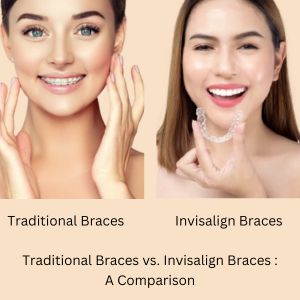What Are Traditional Braces?
Traditional braces are made up of metal brackets, wires, and rubber bands that gradually shift your teeth into the correct position. They are the most common form of orthodontic treatment and are ideal for treating a wide range of dental issues such as severe misalignment, overbites, underbites, and crowded teeth.
Traditional Braces: Tried and True
Traditional braces have been used for decades to straighten teeth and correct bite problems. This method involves metal brackets that are bonded to the teeth, connected by wires and rubber bands, which apply gentle pressure over time to move the teeth into the desired position.
Key Features of Traditional Braces:
- Visible Braces: Metal brackets and wires are more noticeable, which may be a concern for some patients.
- Fixed Treatment: Braces are not removable, so patients must care for them carefully and avoid certain foods.
- Effective for Complex Issues: Traditional braces are ideal for complex dental problems, including severe misalignment and bite issues.
- Frequent Adjustments: Braces require regular visits to Inspire Dental Clinic, for adjustments and tightening.
While traditional braces are highly effective, the visibility and maintenance may be a downside for some individuals, particularly adults or teenagers who prefer a more discreet option.
What is Invisalign?
Invisalign is a modern, clear aligner treatment designed to straighten teeth without the need for metal brackets and wires. Instead, Invisalign uses a series of custom-made, clear plastic aligners that gradually move your teeth into the desired position. These aligners are virtually invisible, making them a popular choice for adults and teens who want to straighten their teeth discreetly.
Invisalign: A Clear Alternative
Invisalign is a modern alternative to traditional braces, offering clear aligners that are virtually invisible. These custom-made aligners are made from smooth, comfortable plastic and are designed to gradually move teeth into the correct position.
Key Features of Invisalign
- Invisible: The aligners are clear and barely noticeable, making them an excellent choice for individuals who want a discreet option.
- Removable: Invisalign aligners can be removed for eating, brushing, and flossing, making them more convenient and allowing for better oral hygiene.
- Comfortable: Unlike traditional braces, which can cause irritation to the gums and mouth, Invisalign aligners are made of smooth plastic and are less likely to cause discomfort.
- Fewer Visits to the Dentist: Invisalign requires fewer in-office visits for adjustments compared to traditional braces. You simply need to change to a new set of aligners every couple of weeks.
Invisalign is ideal for individuals with mild to moderate alignment issues and is especially popular among adults who want to straighten their teeth without the visible appearance of metal braces.

Traditional Braces vs. Invisalign: A Comparison
- Visibility:
Traditional Braces: Highly visible (metal brackets & wires)
Invisalign: Clear and discreet
2. Removability:
Traditional Braces: Cannot be removed
Invisalign: Removable for eating, brushing, etc.
3. Comfort:
Traditional Braces: Can cause irritation and discomfort
Invisalign: More comfortable, no irritation
4. Effectiveness:
Traditional Braces: Ideal for complex cases
Invisalign: Best for mild to moderate cases
5. Treatment Time:
Traditional Braces: Typically 18–24 months
Invisalign: Typically 12–18 months
6. Maintenance:
Traditional Braces: Requires frequent adjustments
Invisalign: Requires fewer visits and aligner changes
7. Cost:
Traditional Braces: Generally lower cost
Invisalign: Higher cost due to custom aligners
8. Dietary Restrictions:
Traditional Braces: Certain foods must be avoided (sticky, hard, or chewy foods can damage braces)
Invisalign: No dietary restrictions as aligners are removed when eating
9. Oral Hygiene:
Traditional Braces: Brushing and flossing can be difficult around the brackets and wires
Invisalign: Easier oral hygiene as aligners are removed for brushing and flossing
10. Risk of Damage:
Traditional Braces: Brackets or wires may break, requiring emergency visits to the dentist
Invisalign: Aligners are more delicate and can crack or get lost, but they are easily replaced
11. Comfort Level:
Traditional Braces: Can cause discomfort or soreness, especially after adjustments
Invisalign: Generally more comfortable, no irritation to gums or cheeks
12. Pain and Discomfort:
Traditional Braces: Some discomfort after adjustments or tightening of the wires
Invisalign: Minimal discomfort when switching to a new set of aligners, but less overall pain compared to braces
Conclusion
When it comes to choosing between traditional braces and Invisalign, both options have their advantages. Traditional braces are often the best choice for complex dental issues and those who don’t mind visible braces.
On the other hand, Invisalign offers a more discreet and comfortable treatment with greater flexibility, making it ideal for those with mild to moderate alignment issues. At Inspire Dental Clinic, we offer both treatments and can help you decide which is best for you. Visit us to schedule a consultation and take the first step towards your perfect smile.

